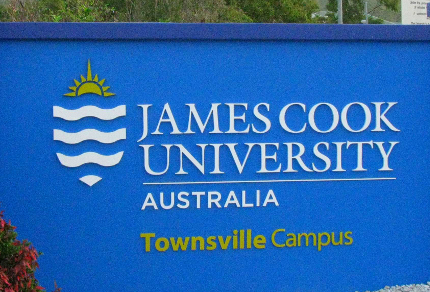
James Cook University Sign (© Magi Nams)
In mid-afternoon, with winter sun pouring down onto Townsville, I cycled to James Cook University to observe a competition featuring 3-minute research presentations. The competitors represented both science and engineering schools and were slotted into one of three categories: Ph.D. students, early-career faculty, and established faculty. The aim of the competition was to showcase the talent of JCU science and engineering researchers at different career levels, with the winner in each category slated to face off against competitors from other JCU schools at a future date, after which the winners from that competition would head off to Brisbane for a statewide competition.
The engineering lecture room in which the competition was held soon filled to overflowing with spectators exuding classic, good-natured Aussie humour and banked excitement no doubt inspired by contemplating the challenge of distilling years of scientific research into 180 seconds. A quirky and quick-witted Master of Ceremonies introduced the requirements of the competition, which were essentially that each of the ten competitors must present a tight, compelling story to a scientific but not specialized audience, a story including what the project was, how it was researched, what the results were, and how (the emcee laughed at this) the study relates to the real world.
Three judges from science and English departments of Townsville high schools sat at the front of the audience, their task to choose the victors. The first four contestants were Ph.D. students whose projects varied from the use of reefs and mangroves by blacktip reef sharks, to next-generation bone implants made of magnesium coated with a biodegradable surface, to the effect of climate change on endangered northern bettongs, to the role of riparian (riverside) vegetation in reducing river discharge of agricultural nitrate pollution into nearshore coral reefs. They were fast, and a couple of them had the cleanest presentations in the entire competition.
The early career researchers presented an entirely different suite of work, from constructing building materials with re-use in mind, to fish poisoning by bacterial toxins and its implications for humans, to predicting the spatial distribution of earthquake aftershocks in order to alert earthquake victims of future dangers. The established career competitors tackled understandably larger topics ranging from the effects of multi-use water management on an endangered species, to a complex system employing algae to sequester carbon dioxide and transform it into useful products, to the birth of stars in our galaxy.
For three minutes at a time, the audience was caught up in scientific mini-sagas, in research hotspots, and everyone was counting – some, like Vilis, with stopwatches; some, like me, in the mind. The end of each presentation was accompanied by applause, expelled breaths, and excited laughter. This brief taste of scientific and engineering expertise gave all of us a glimpse of JCU’s talent as a research institute, a talent that’s been recognized in the university’s 52nd-place world ranking in environment and ecology. Even more outstanding, in the field of climate change, JCU is No. 2 in the world, muscled right in there between two of the world’s heavyweight research institutions – the Smithsonian Institution, at No. 1, and NASA, at No. 3. I’m impressed.


